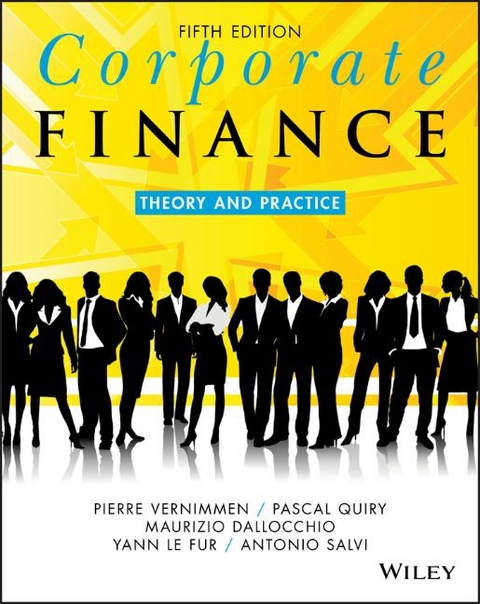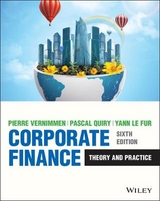
Corporate Finance
John Wiley & Sons Inc (Verlag)
978-1-119-42448-2 (ISBN)
- Titel erscheint in neuer Auflage
- Artikel merken
Corporate Finance has long been a favourite among both students and professionals in the field for its unique blend of theory and practice with a truly global perspective. The fact that the authors are well-known academics and professionals in the world of mergers and acquisitions (M&A) and investment explains this popularity. This new Fifth Edition continues the tradition, offering a comprehensive tour of the field through scenario-based instruction that places concept and application in parallel. A new chapter has been added, devoted to the financial management of operating buildings that aims to answer questions such as, “to own or to rent?” “variable or fixed rents?” etc. The book’s companion website features regularly updated statistics, graphs and charts, along with study aids including quizzes, case studies, articles, lecture notes and computer models, reflecting the author team’s deep commitment to facilitating well-rounded knowledge of corporate finance topics. In addition, a monthly free newsletter keeps the readers updated on the latest developments in corporate finance as well as the book’s Facebook page, which publishes a post daily.
Financial concepts can be quite complex, but a familiar setting eases understanding while immediate application promotes retention over simple memorisation. As comprehensive, relevant skills are the goal, this book blends academic and industry perspective with the latest regulatory and practical developments to provide a complete corporate finance education with real-world applicability.
Blend theory and practice to gain a more relevant understanding of corporate finance concepts
Explore the field from a truly European perspective for a more global knowledge base
Learn essential concepts, tools and techniques by delving into real-world applications
Access up-to-date data, plus quizzes, case studies, lecture notes and more
A good financial manager must be able to analyse a company’s economic, financial and strategic situation, and then value it, all while mastering the conceptual underpinnings of all decisions involved. By emphasising the ways in which concepts impact and relate to real-world situations, Corporate Finance provides exceptional preparation for working productively and effectively in the field.
Pierre Vernimmen (deceased) Graduate of HEC and Harvard, was a founding member and first coordinator of the Finance Department at HEC, where he established himself as a leading academic in the field of corporate finance.?In 1973 he joined Paribas, initially as a private equity banker, moving onto the advisory business line (M&A, privatisations, financial restructurings) which he set up and managed from 1993 until his death in 1996. Pascal Quiry (Paris, France) is MD in the Corporate Finance department at BNP Paribas, and affiliate professor of finance at HEC.?He leads two 8-member teams which carry out company valuations and stock exchange transactions (takeover bids, exchange offers, demergers etc.). Pascal is board member of the French Finance Association and member of the American Finance Association. Yann Le Fur?(Paris, France) is a senior associate in the Paris Corporate Finance department of Schroder Salomon Smith Barney, and a lecturer at HEC. He co-manages a team of 5 professionals. Maurizio Dallocchio (Milan, Italy) former Dean of the leading Italian business school Bocconi (Milan) and Lehman Brothers Chair of Corporate Finance. He is also a board member of several listed and unlisted companies and is one of the most distinguished Italian authorities on finance. Antonio Salvi (Milan, Italy) is an Assistant Professor of Finance at Bocconi and the University of Venice where he teaches Corporate Finance. His areas of research cover cost of capital, structure of debt finance and corporate governance.
Preface viii
Frequently used symbols xii
1 What is Corporate finance? 1
Section 1 Financial Analysis? 15
Part One Fundamental Concepts in Financial Analysis 17
2 Cash Flow 19
3 Earnings 29
4 Capital Employed and Invested Capital 44
5 Walking Through from Earnings to Cash Flow 57
6 Getting to Grips with Consolidated Accounts 71
7 How to Cope with the Most Complex Points in Financial Accounts 88
Part Two Financial Analysis and Forecasting 115
8 How to Perform a Financial Analysis 117
9 Margin Analysis: Structure 141
10 Margin Analysis: Risks 164
11 Working Capital and Capital Expenditures 179
12 Financing 201
13 Return on Capital Employed and Return on Equity 216
14 Conclusion and Financial Analysis 235
Section II Investors and Markets 243
Part One Investment Decision Rules 245
15 The Financial Markets 247
16 The Time Value of Money and Net Present Value 267
17 The Internal Rate of Return 284
Part Two The Risk of Securities and the Required Rate of Return 297
18 Risk and Return 299
19 The Required Rate of Return 327
Part Three Financial Securities 345
20 Bonds 347
21 Other DEBT Products 369
22 Shares 384
23 Options 404
24 Hybrid Securities 425
25 Selling Securities 443
Section III Value 469
26 Value and Corporate Finance 471
27 Measuring Value Creation 490
28 Investment Criteria 508
29 The Cost of Capital 526
30 Risk and Investment Analysis 543
31 Valuation Techniques 555
Section IV Corporate Financial Policies 585
Part One Capital Structure Policies 587
32 Capital Structure and the Theory of Perfect Capital Markets 589
33 Capital Structure, Taxes and Organisation Theories 601
34 DEBT, Equity and Options Theory 618
35 Working Out Details: The Design of the Capital Structure 637
Part Two Equity Capital 657
36 Returning Cash to Shareholders 659
37 Distribution in Practice: Dividends and Share Buy-Backs 676
38 Share Issues 692
Part Three DEBT Capital 705
39 Implementing a DEBT Policy 707
Section V Financial Management 725
Part One Corporate Governance and Financial Engineering 727
40 Setting Up a Company or Financing Start-Ups 729
41 Choice of Corporate Structure 748
42 Initial Public Offerings (IPOs) 771
43 Corporate Governance 783
44 Taking Control of A Company 796
45 Mergers and Demergers 819
46 Leveraged Buyouts (LBOs) 836
47 Bankrupicy and Restructing 851
Part Two Managing Working Capital, Cash Flows, Financial Risks and Real Estate 863
48 Managing Working Capital 865
49 Cash Management 878
50 Managing Financial Risks 897
51 Managing Operational Real Estate 922
Epilogue – Finance and Strategy 935
Top 20 Largest Listed Companies 943
Contents 951
Index 961
| Erscheinungsdatum | 29.10.2017 |
|---|---|
| Verlagsort | New York |
| Sprache | englisch |
| Maße | 190 x 242 mm |
| Gewicht | 1788 g |
| Themenwelt | Wirtschaft ► Betriebswirtschaft / Management |
| ISBN-10 | 1-119-42448-8 / 1119424488 |
| ISBN-13 | 978-1-119-42448-2 / 9781119424482 |
| Zustand | Neuware |
| Haben Sie eine Frage zum Produkt? |
aus dem Bereich



